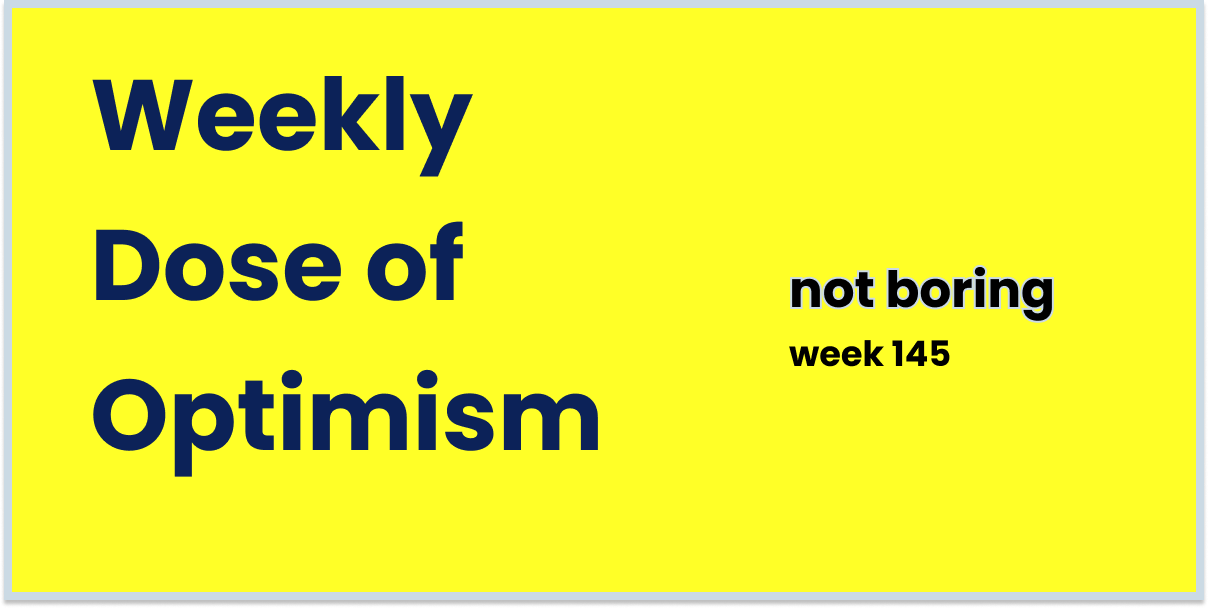Weekly Dose of Optimism #145
Sam & Jony, Google I/O, Nuclear EOs, Creatine & Alzheimer's, CRISPR, Abundance, Two Vaticans with Reggie James
Hi friends 👋,
Happy Friday and welcome back to our 145th Weekly Dose of Optimism. This week we got lots of AI launches, a nuclear investment thesis, very promising creatine x Alzheimer’s research, an overview of the Abundance Institute, and the lastest epsiode of Hyperlegible with Reggie James. Intelligence, Energy, Health, Abundance, and God. That’s a lineup about as “Weekly Dose” as a Weekly Dose gets.
Let’s get to it.
Today’s Weekly Dose is brought to you by… INBOUND
Get the full story from some of the world’s best founders. At INBOUND 2025 in San Francisco, you'll go beyond surface-level success narratives to understand the systems behind today's fastest-growing companies.
Connect with AI leaders like Dharmesh Shah, Dario Amodei, and Dwarkesh Patel who will break down the scientific principles behind their scaling companies and media empires. At INBOUND, you'll get frameworks specifically designed for today's AI-driven business environment.
San Francisco's startup ecosystem becomes your classroom for three days. Form connections with potential co-founders, investors, and strategic partners who understand how operational excellence enables transformative innovation.
Not Boring subscribers receive 10% off their INBOUND General Admission ticket with code NOTBORING10 (Valid thru 7/31). Don't just read about the future, be a part of it.
From OpenAI
The io team, focused on developing products that inspire, empower and enable, will now merge with OpenAI to work more intimately with the research, engineering and product teams in San Francisco.
As io merges with OpenAI, Jony and LoveFrom will assume deep design and creative responsibilities across OpenAI and io.
We could not possibly be more excited.
Sam & Jony
OpenAI is merging with Jony Ive’s stealthy device company io, and the joint launch video is so well done that you can’t watch it without feeling optimistic about what Sam and Jony are going to build together.
The $6.5B all-stock move brings Ive and a team of ex-Apple designers into OpenAI to lead hardware and design efforts, marking OpenAI’s major push into AI-powered consumer devices. LoveFrom, Ive’s design firm, will oversee creative direction across OpenAI’s product ecosystem.
There’s ton of speculation around what this new collab’s first product will be and Altman and Ive fueled the hype in the video, claiming the early prototype is the best work of Jonny’s career. Famously, Jony led design for the iPhone and MacBook Air and basically every iconic Apple product over the last 30 years. So “best work” sets a very high standard.
OpenAI is generally setting an extremely high standard right now. They’re building an absolute killer leadership team (Jony and Fidji are two recent examples), they’re making ambitious, massive bets into hardware and compute, there’s a very non-zero chance they can disrupt search in the next couple of years, and are probably pretty close to what could reasonably be considered AGI.
As Packy wrote in Everything is Technology, new companies can topple seemingly untouchable incumbents with surprising speed. We’re not sure if that’s what’s happening here yet, but it’s really fun to watch.
(2) Google I/O
From Google
But then there’s Google. The $2T+ company isn’t going to take OpenAI lying down. Search, today, is still a cash cow. Its cloud business is massive and growing. Waymo looks like it’ll be a $100B+ business unit in the not so distant future. It’s pushing the envelope on quantum computing. And oh yeah, it basically invented AI as we know it today, has the best (by many standards) AI models, and hundreds of places to inject AI into already useful products.
At its 2025 I/O (big week for IOs!), Google predictably dedicated most of its time and hype towards AI. Gemini, took center stage with advancements across all products. "AI Mode" in Search and Project Astra, a universal AI assistant, promise more natural and proactive interactions. New AI models like Veo 3 (video with audio) and Imagen 4 (higher clarity images) were unveiled, alongside Flow, an AI filmmaking tool. SynthID Detector was also announced to help identify AI-generated content.
Google might not be as craftful in how it brings things to market or as splashy as OpenAI today, but it’s got unlimited resources, multiple big ($100B-$1T) bets current in play, and is using its distribution to get AI into the hands of more users than any other company in the world. Don’t sleep on Google.
Mini-Bonus: Anthropic releases Claude Opus 4 and Claude Sonnet 4
Not to be forgotten, Anthropic released its newest family of models yesterday. We’re big fans of Claude’s personality and style, and excited to play with the new toys. Our friend Dan Shipper at Every got early access, and his review is overall very positive.
Big week for AI. With so much competition, the only guaranteed winner is the consumer (good news, folks: that’s us).
(3) Trump Nuclear Power Update as New Order May Bring Back Cold War-Era Act
Gabe Whisnant for Newsweek
A Cold War-era statute could soon return to the forefront of American energy policy, as President Donald Trump prepares to sign a series of executive orders…to jumpstart the domestic nuclear energy industry…the forthcoming orders aim to simplify the regulatory process for approving new nuclear reactors and to strengthen nuclear fuel supply chains amid mounting concerns over U.S. dependence on foreign suppliers.
They don’t call him Donny Nukes for nothing! Nuke baby nuke!
President Trump is set to sign executive orders to revive U.S. nuclear energy, declaring a national energy emergency to address rising power demand from AI and data centers. The orders aim to simplify reactor approvals, boost domestic uranium supply chains, and identify federal lands for nuclear development.
The Trump Administration’s view on energy needs aligns pretty closely with our own: we need more of it. We’re going to need more energy whether its from LNG, drilling, nuclear, solar & batteries, etc. And sometimes you gotta crack a few government regulations to make an energy omelette, right?
Packy note: In speaking with a bunch of nuclear founders, this EO would be a massive accelerant for the development of new nuclear in the USA. One I spoke to said it meant their company could have a reactor live and operational next year. This is a big, big win.
And as the government makes it easier for nuclear build out, the private industry is looking at ways to play the opportunity.
Kelly Greer of Crucible Capital published Understanding the Nuclear Value Chain, a detailed report, on the value chain of nuclear energy, with a particular focus on uranium enrichment and TRISO fuel fabrication. Greer’s thesis is that there’s been a decades long under-investment in nuclear fuel infrastructure, and that this infrastructure will need to be built and financed in order to unlock the promise of next-gen nuclear power.
At the center of this thesis is TRISO fuel. TRISO fuel is a type of advanced nuclear fuel made of tiny uranium particles coated in ceramic layers, designed to withstand extreme heat and prevent radioactive leaks. It’s safer and more efficient than traditional nuclear fuel. Right now the U.S. relies heavily on foreign adversaries like Russia and China for enrichment and fabrication, which poses obvious national security and supply chain risks. TRISO is the linchpin technology for nuclear, yet the infrastructure to support it domestically is nearly nonexistent.
Crucible isn’t alone in seeing that value in nuclear over the coming decades. The U.S. is trailing behind in a big way and will need to build out capaicty to keep up. But rather than betting on reactor builders, Crucible is betting in TRISO fuel production via their investment in Standard Nuclear. (We’re betting on the same thing and the same company through Not Boring Capital.) The idea is to own a portion of the most valuable but uninvested into area of the nuclear value chain. Let’s hope Crucible, and frankly all of the investors making nuclear bets, are eventually proven right.
(4) Creatine monohydrate pilot in Alzheimer's: Feasibility, brain creatine, and cognition
Smith et al for The Alzheimer’s Association
Our data suggest that CrM supplementation is feasible in AD and provides preliminary evidence for future efficacy and mechanism studies.
OK, this one is personal for me on two fronts.
Personally, my grandmother suffered from a very advanced case of Alzheimer’s the entire time I knew her. She couldn’t talk. She couldn’t walk. She barely responded to stimulus. For me, as a young child, it was just kind of foreign and scary. But for my mom, watching the deterioration of her mother over the course of 10-20 years was pretty shattering. For the last 20 years or so, I’ve had a deep fear that either my mom or one of my siblings would eventually suffer from the genetic mutation that causes Alzheimer’s. And because of that, I’ve kept my ear very close to the ground on Alzheimer’s research and new therapeutics.
Professionally, I run a creatine company. I didn’t get into creatine because of its potential as a therapeutic for Alzheimer’s. I got into creatine because I generally thought building strength and having high levels of energy was a good thing and that creatine could help people achieve that. But once I got into the world of creatine, I discovered there was a small, but growing body of research around creatine as a potential therapeutic for neurodegenerative diseases. Most of this research was pretty theoretical: this is how creatine works in the body, this is how neurodegenerative diseases work, and you could connect some logic and hypothesize that creatine could play a role in treating these diseases.
Now, we have a first-of-its-kind human trial that measured creatine supplementation’s impact on patients with Alzheimer’s Disease and the results we’re pretty compelling. The study, which was admittedly small, took 20 patients with Alzheimer’s and gave them 20g of creatine monohydrate per day for 8 weeks. These were the findings:
Adherence: 19/20 participants were 80% compliant with the intervention, meaning the patients could feasibly take 20g of creatine per day of an extended period of time.
Brain Creatine: Total brain creatine increased 11%. Total brain creatine reflects the brain’s energy reserves, and showing that creatine supplementation can increase it proves the brain is absorbing and storing more fuel, an essential step for improving energy metabolism and potentially slowing cognitive decline in Alzheimer’s.
Cognitive Function: Creatine supplementation led to modest but significant (5-12%) improvements in overall cognition, especially in working memory, fluid intelligence, and reading ability.
The study was an early but promising proof point that creatine supplementation is a safe, feasible, and potentially effective intervention for treating some of the symptoms of AD. Of course consult a doctor, but if you or someone you know are suffering from these symptoms, creatine seems like a low-risk/high-reward intervention. Creatine certainly isn’t a cure and it’s not a silver bullet for symptoms, but these results demand further investigation into creatine’s potential as a potential therapeutic for a whole swath of neurodegenerative diseases.
(5) World first: ultra-powerful CRISPR treatment trialled in a person
Heidi Ledford for Nature
The CRISPR family’s most versatile member has made its medical debut: a cutting-edge gene-editing technique known as prime editing has been used to treat a person for the first time. The recipient is a teenager with a rare immune disorder.
On the heels of last week’s heartwarming personalized gene-editing story, a biotech company called Prime Research has used a CRISPR prime editing treatment to treat a patient for the first time, a teenager with a rare immune disorder.
From Nature: “Researchers designed the treatment to correct a mutation that causes chronic granulomatous disease, a dangerous condition that disables a variety of immune cells, including those called neutrophils. A month after the teenager received the treatment, he had experienced no serious side effects. And the therapy seemed to have restored the function of a crucial enzyme in two-thirds of his neutrophils — more than enough to provide a significant boost to his immune system.”
According to the researchers, prime editing is an upgrade to the CRISPR-Cas9 treatments we’ve covered in the Dose previously.
It will take six months to a year to understand whether this treatment was a full success, but it’s another example of gene therapies being used to treat people who would otherwise have no real hope for a cure. What a time to be alive (for longer and healthier
BONUS: Abundance Institute Policy Summit and Gala
Packy here. On Monday, I spent the day in Washington, DC for the Abundance Institute’s Policy Summit + Gala celebrating the group’s one year birthday.
Abundance Institute’s twitter has a full rundown of the talks and panels here and here, so I won’t rehash everything, but I wanted to share some thoughts on why I got so much out of the day, some of which I shared on stage at the Gala.
A year and a half ago, The New Yorker published an article titled The Morality of Having Kids in a Burning, Drowning World. The thrust was: how could you possibly bring a child into this terrible world?! I wrote my response in The Morality of Having Kids in a Magical, Maybe Simulated World. The thrust was: I am incredibly jealous of everything that my kids are going to experience. They’ll get autonomous cars and flying cars and supersonic flights and AI tutors, and I think there’s a good shot they’ll get to go to space. Hopefully, we get a longevity take-off, and we all get to experience all of this and more, but in either case, there’s a good chance that they live to see the eradication of cancer and a number of other deadly diseases. Already, obesity is getting shot to pieces, and just last week, we talked about the baby who was cured with the first personalized gene-editing treatment. What a wonderful world.
If you’ve been reading Not Boring, you can probably tell that I think the solutions to so many of the challenges humanity faces can be found at the intersection of new technologies and the business models that support their spread.
But I’ve come to learn that technology and business model alone aren’t enough. I’ve spent enough time in crypto to see what happens when regulators try to choke a new technology before it gets a chance to mature (that, luckily, has failed; Bitcoin is at all-time highs and stablecoin adoption is spreading like wildfire). I did the first season of Age of Miracles on nuclear because I wanted to understand how we could have discovered a miracle technology, an energy source orders of magnitude more energy dense than alternatives that was also cleaner and safer, and then, after an initial boom, made it practically illegal to build. We now have self-driving cars on the streets of San Francisco and Austin, and crowds set them on fire.
Technology and business models are crucially important, but it turns out that to get the future we want for ourselves and for our kids, you need good culture and you need good policy. Policy, in particular, is a world I knew very little about, but that I’ve come to realize is critical to everything else that we want.
Throughout the day Monday, I got to watch and talk to people in the policy trenches — wonks, politicians, entrepreneurs, and funders — who are working the intricate process it takes to make good policy happen in energy, telecommunications, AI, crypto, manufacturing, and beyond.
Each has their personal angle on the future, but all share a vision for an America that builds, for a future that is better than the present, and for a present that’s pretty great. As importantly, they’re translating that vision into specific legislation that makes it all possible.
I particularly like the tag line they’ve been using: Optimism Always Wins.
DOUBLE BONUS: Hyperlegible: A tale of two Vaticans (or, OpenAI building an unholy spirit) with Reggie James
Packy again with a little bonus treat. Of course, as technology, business models, and policy take care of our material needs, there’s still the spiritual needs to think about.
Reggie James is one of my favorite people writing about tech, culture, and religion, and on the heels of the election of an American Pope, he wrote an essay on the relationship between technology and spirituality, between Silicon Valley and Rome, and between Sam Altman and Pope Leo VIX.
No one but Reggie could have written this piece, which is the highest praise I can give to a writer. It combines his deep knowledge of the history of Silicon Valley, his Christianity, and his willingness to "critique the gods." And it gave me an excuse to cover a topic I've been wanting to talk about for a while -- the rise of Christianity and the search for meaning -- with the best person I know to have that conversation with.
You can find our conversation wherever you get podcasts, like YouTube and Spotify:
While you’re there, if you could like and subscribe, it would go a long way in spreading the best things written on the internet each week and it costs you $0.
And you can find Reggie’s essay, and all of the essays we’ve discussed on Hyperlegible, thanks to our sponsor Readwise, at readwise.io/hyperlegible.
Have a great weekend y’all.
Thanks to INBOUND 2025 for sponsoring. We’ll be back in your inbox next week.
Thanks for reading,
Packy + Dan










Sam & Jony had a farm, a-i-a-i-o
Man is there a lot to like here, particularly if you’re a fan of nuclear power or AI. And if you’re Apple, or an Apple shareholder, there’s more than a little to worry about. Tim Cook, Clayton Christensen would like a word.